Assessment of Diagnostic Specificity of Anti-SARS-CoV-2 Antibody Tests and Their Application for Monitoring of Seroconversion and Stability of Antiviral Antibody Response in Healthcare Workers in Moscow
Abstract
:1. Introduction
2. Materials and Methods
2.1. Study Design
2.2. Study Participants and Study Samples
2.3. Tests Used to Assess Anti-SARS-CoV-2 Antibodies
2.4. Assessment of the Specificity of Anti-SARS-CoV-2 Tests
2.5. Determination of the Limit of Detection of Anti-SARS-CoV-2 Tests
2.6. Evaluation of Correlation between Cut-Off Indexes Obtained in Qualitative and Anti-SARS-CoV-2 Antibody Concentrations Obtained in Quantitative Test
2.7. Monitoring of the Anti-SARS-CoV-2 Seroconversion in Cohort of Healthcare Workers
2.8. Statistical Analysis
3. Results
3.1. Performance of Anti-SARS-CoV-2 Tests
3.2. Correlation of COIs Obtained in Qualitative #3 (SARS-CoV-2-IgG-IFA-BEST) and #5 (Elecsys Anti-SARS-CoV-2) Tests and Anti-SARS-CoV-2 Antibody Concentrations in Quantitative # 6 (Elecsys Anti-SARS-CoV-2 S) Test
3.3. Anti-SARS-CoV-2 Prevalence Rates at Initial Screening Conducted at Different Stages of COVID-19 Pandemic
3.4. Duration of Reactivity for IgM Antibodies to SARS-CoV-2
3.5. Monthly Rates of Anti-SARS-CoV-2 Seroconversion in Cohort of Healthcare Professionals
3.6. Changes in Anti-S Antibody Concentrations during the Follow-Up for More Than 6 Months
4. Discussion
5. Conclusions
Supplementary Materials
Author Contributions
Funding
Institutional Review Board Statement
Informed Consent Statement
Data Availability Statement
Acknowledgments
Conflicts of Interest
References
- WHO Coronavirus (COVID-19) Dashboard. Available online: https://covid19.who.int (accessed on 1 February 2022).
- Coronavirus: Statistics. Available online: https://yandex.ru/covid19/stat/index (accessed on 1 February 2022).
- Interim Guidelines for Prevention, Diagnosis and Treatment of COVID-19. Version 14 (27 December 2021). Available online: https://static-0.minzdrav.gov.ru/system/attachments/attaches/000/059/041/original/%D0%92%D0%9C%D0%A0_COVID-19_V14_27-12-2021.pdf (accessed on 2 February 2022).
- Health Center for Devices and Radiological In Vitro Diagnostics EUAs. Available online: https://www.fda.gov/medical-devices/coronavirus-disease-2019-covid-19-emergency-use-authorizations-medical-devices/in-vitro-diagnostics-euas (accessed on 1 February 2022).
- CDC Healthcare Workers. Available online: https://www.cdc.gov/coronavirus/2019-ncov/hcp/testing-overview.html (accessed on 1 February 2022).
- Falzone, L.; Gattuso, G.; Tsatsakis, A.; Spandidos, D.A.; Libra, M. Current and Innovative Methods for the Diagnosis of COVID-19 Infection (Review). Int. J. Mol. Med. 2021, 47, 100. [Google Scholar] [CrossRef]
- Chen, M.; Qin, R.; Jiang, M.; Yang, Z.; Wen, W.; Li, J. Clinical Applications of Detecting IgG, IgM or IgA Antibody for the Diagnosis of COVID-19: A Meta-Analysis and Systematic Review. Int. J. Infect. Dis. 2021, 104, 415–422. [Google Scholar] [CrossRef] [PubMed]
- Ma, H.; Zeng, W.; He, H.; Zhao, D.; Jiang, D.; Zhou, P.; Cheng, L.; Li, Y.; Ma, X.; Jin, T. Serum IgA, IgM, and IgG Responses in COVID-19. Cell. Mol. Immunol. 2020, 17, 773–775. [Google Scholar] [CrossRef] [PubMed]
- Rashid-Abdi, M.; Krifors, A.; Sälléber, A.; Eriksson, J.; Månsson, E. Low Rate of COVID-19 Seroconversion in Health-Care Workers at a Department of Infectious Diseases in Sweden during the Later Phase of the First Wave; a Prospective Longitudinal Seroepidemiological Study. Infect. Dis. 2021, 53, 169–175. [Google Scholar] [CrossRef] [PubMed]
- World Health Organization. Diagnostic Testing for SARS-CoV-2: Interim Guidance, 11 September 2020; World Health Organization: Geneva, Switzerland, 2020. [Google Scholar]
- Woo, P.C.; Lau, S.K.; Wong, B.H.; Tsoi, H.; Fung, A.M.; Kao, R.Y.; Chan, K.; Peiris, J.M.; Yuen, K. Differential Sensitivities of Severe Acute Respiratory Syndrome (SARS) Coronavirus Spike Polypeptide Enzyme-Linked Immunosorbent Assay (ELISA) and SARS Coronavirus Nucleocapsid Protein ELISA for Serodiagnosis of SARS Coronavirus Pneumonia. J. Clin. Microbiol. 2005, 43, 3054–3058. [Google Scholar] [CrossRef] [PubMed] [Green Version]
- Che, X.; Qiu, L.; Pan, Y.; Wen, K.; Hao, W.; Zhang, L.; Wang, Y.; Liao, Z.; Hua, X.; Cheng, V.C.C.; et al. Sensitive and Specific Monoclonal Antibody-Based Capture Enzyme Immunoassay for Detection of Nucleocapsid Antigen in Sera from Patients with Severe Acute Respiratory Syndrome. J. Clin. Microbiol. 2004, 42, 2629–2635. [Google Scholar] [CrossRef] [Green Version]
- Okba, N.M.A.; Müller, M.A.; Li, W.; Wang, C.; GeurtsvanKessel, C.H.; Corman, V.M.; Lamers, M.M.; Sikkema, R.S.; de Bruin, E.; Chandler, F.D.; et al. Severe Acute Respiratory Syndrome Coronavirus 2−Specific Antibody Responses in Coronavirus Disease Patients. Emerg. Infect. Dis. 2020, 26, 1478–1488. [Google Scholar] [CrossRef]
- Perera, R.A.; Mok, C.K.; Tsang, O.T.; Lv, H.; Ko, R.L.; Wu, N.C.; Yuan, M.; Leung, W.S.; Chan, J.M.; Chik, T.S.; et al. Serological Assays for Severe Acute Respiratory Syndrome Coronavirus 2 (SARS-CoV-2), March 2020. Eurosurveillance 2020, 25, 2000421. [Google Scholar] [CrossRef] [Green Version]
- Mallano, A.; Ascione, A.; Flego, M. Antibody Response against SARS-CoV-2 Infection: Implications for Diagnosis, Treatment and Vaccine Development. Int. Rev. Immunol. 2021, 1–21. [Google Scholar] [CrossRef]
- Bradley, B.T.; Bryan, A.; Fink, S.L.; Goecker, E.A.; Roychoudhury, P.; Huang, M.-L.; Zhu, H.; Chaudhary, A.; Madarampalli, B.; Lu, J.Y.C.; et al. Anti-SARS-CoV-2 Antibody Levels Measured by the AdviseDx SARS-CoV-2 Assay Are Concordant with Previously Available Serologic Assays but Are Not Fully Predictive of Sterilizing Immunity. J. Clin. Microbiol. 2021, 59, e0098921. [Google Scholar] [CrossRef]
- Creech, C.B.; Walker, S.C.; Samuels, R.J. SARS-CoV-2 Vaccines. JAMA 2021, 325, 1318–1320. [Google Scholar] [CrossRef]
- von Huth, S.; Lillevang, S.T.; Røge, B.T.; Madsen, J.S.; Mogensen, C.B.; Coia, J.E.; Möller, S.; Justesen, U.S.; Johansen, I.S. SARS-CoV-2 Seroprevalence among 7950 Healthcare Workers in the Region of Southern Denmark. Int. J. Infect. Dis. 2021, 112, 96–102. [Google Scholar] [CrossRef]
- Grant, J.J.; Wilmore, S.M.S.; McCann, N.S.; Donnelly, O.; Lai, R.W.L.; Kinsella, M.J.; Rochford, H.L.; Patel, T.; Kelsey, M.C.; Andrews, J.A. Seroprevalence of SARS-CoV-2 Antibodies in Healthcare Workers at a London NHS Trust. Infect. Control. Hosp. Epidemiol. 2021, 42, 212–214. [Google Scholar] [CrossRef] [PubMed]
- Houlihan, C.F.; Vora, N.; Byrne, T.; Lewer, D.; Kelly, G.; Heaney, J.; Gandhi, S.; Spyer, M.J.; Beale, R.; Cherepanov, P.; et al. Pandemic Peak SARS-CoV-2 Infection and Seroconversion Rates in London Frontline Health-Care Workers. Lancet 2020, 396, e6–e7. [Google Scholar] [CrossRef]
- Decree of the Chief State Sanitary Doctor of the Russian Federation Dated May 22, 2020 No. 15 on Approval of the Sanitary and Epidemiological Rules SP 3.1.3597-20 “Prevention of a New Coronavirus Infection (COVID-19)”. Available online: http://www.garant.ru/products/ipo/prime/doc/74077903/ (accessed on 1 February 2022).
- Coronaviridae Study Group of the International Committee on Taxonomy of Viruses The Species Severe Acute Respiratory Syndrome-Related Coronavirus: Classifying 2019-NCoV and Naming It SARS-CoV-2. Nat. Microbiol. 2020, 5, 536–544. [CrossRef] [PubMed] [Green Version]
- Charlton, C.L.; Kanji, J.N.; Johal, K.; Bailey, A.; Plitt, S.S.; MacDonald, C.; Kunst, A.; Buss, E.; Burnes, L.E.; Fonseca, K.; et al. Evaluation of Six Commercial Mid- to High-Volume Antibody and Six Point-of-Care Lateral Flow Assays for Detection of SARS-CoV-2 Antibodies. J. Clin. Microbiol. 2020, 58, e01361-20. [Google Scholar] [CrossRef] [PubMed]
- Hicks, J.; Klumpp-Thomas, C.; Kalish, H.; Shunmugavel, A.; Mehalko, J.; Denson, J.-P.; Snead, K.R.; Drew, M.; Corbett, K.S.; Graham, B.S.; et al. Serologic Cross-Reactivity of SARS-CoV-2 with Endemic and Seasonal Betacoronaviruses. J. Clin. Immunol. 2021, 41, 906–913. [Google Scholar] [CrossRef]
- Woudenberg, T.; Pelleau, S.; Anna, F.; Attia, M.; Donnadieu, F.; Gravet, A.; Lohmann, C.; Seraphin, H.; Guiheneuf, R.; Delamare, C.; et al. Humoral Immunity to SARS-CoV-2 and Seasonal Coronaviruses in Children and Adults in North-Eastern France. EBioMedicine 2021, 70, 103495. [Google Scholar] [CrossRef]
- Letter of the Federal Service for Supervision in the Sphere of Healthcare Dated July 5, 2021. Available online: http://ivo.garant.ru/#/document/401481102/paragraph/1:0 (accessed on 1 February 2022).
- WHO/BS.2020.2403 Establishment of the WHO International Standard and Reference Panel for Anti-SARS-CoV-2 Antibody. WHO: Geneva, Switzerland, 2020. Available online: https://www.who.int/publications/m/item/WHO-BS-2020.2403 (accessed on 2 December 2021).
- Premkumar, L.; Segovia-Chumbez, B.; Jadi, R.; Martinez, D.R.; Raut, R.; Markmann, A.; Cornaby, C.; Bartelt, L.; Weiss, S.; Park, Y.; et al. The Receptor Binding Domain of the Viral Spike Protein Is an Immunodominant and Highly Specific Target of Antibodies in SARS-CoV-2 Patients. Sci. Immunol. 2020, 5, eabc8413. [Google Scholar] [CrossRef]
- Chen, Z.; Pei, D.; Jiang, L.; Song, Y.; Wang, J.; Wang, H.; Zhou, D.; Zhai, J.; Du, Z.; Li, B.; et al. Antigenicity Analysis of Different Regions of the Severe Acute Respiratory Syndrome Coronavirus Nucleocapsid Protein. Clin. Chem. 2004, 50, 988–995. [Google Scholar] [CrossRef] [Green Version]
- Yamaoka, Y.; Jeremiah, S.S.; Miyakawa, K.; Saji, R.; Nishii, M.; Takeuchi, I.; Ryo, A. Whole Nucleocapsid Protein of Severe Acute Respiratory Syndrome Coronavirus 2 May Cause False-Positive Results in Serological Assays. Clin. Infect. Dis. 2021, 72, 1291–1292. [Google Scholar] [CrossRef]
- Gobbi, F.; Buonfrate, D.; Moro, L.; Rodari, P.; Piubelli, C.; Caldrer, S.; Riccetti, S.; Sinigaglia, A.; Barzon, L. Antibody Response to the BNT162b2 MRNA COVID-19 Vaccine in Subjects with Prior SARS-CoV-2 Infection. Viruses 2021, 13, 422. [Google Scholar] [CrossRef]
- Shapovalov, K.; Stepanov, A.; Burdinskaya, J. Three-month results of vaccination of monostationary health workers with the drug «Gam-Covid-Vac». Immunologiya 2021, 42, 125–130. [Google Scholar] [CrossRef]
- Kasztelewicz, B.; Janiszewska, K.; Burzyńska, J.; Szydłowska, E.; Migdał, M.; Dzierżanowska-Fangrat, K. Prevalence of IgG Antibodies against SARS-CoV-2 among Healthcare Workers in a Tertiary Pediatric Hospital in Poland. PLoS ONE 2021, 16, e0249550. [Google Scholar] [CrossRef]
- Alkurt, G.; Murt, A.; Aydin, Z.; Tatli, O.; Agaoglu, N.B.; Irvem, A.; Aydin, M.; Karaali, R.; Gunes, M.; Yesilyurt, B.; et al. Seroprevalence of Coronavirus Disease 2019 (COVID-19) among Health Care Workers from Three Pandemic Hospitals of Turkey. PLoS ONE 2021, 16, e0247865. [Google Scholar] [CrossRef] [PubMed]
- Barallat, J.; Fernández-Rivas, G.; Quirant-Sánchez, B.; González, V.; Doladé, M.; Martinez Caceres, E.; Piña, M.; Aguilar, J.; Estrada, O.; Blanco, I. Seroprevalence of SARS-CoV-2 IgG Specific Antibodies among Healthcare Workers in the Northern Metropolitan Area of Barcelona, Spain, after the First Pandemic Wave. PLoS ONE 2020, 15, e0244348. [Google Scholar] [CrossRef] [PubMed]
- Galanis, P.; Vraka, I.; Fragkou, D.; Bilali, A.; Kaitelidou, D. Seroprevalence of SARS-CoV-2 Antibodies and Associated Factors in Healthcare Workers: A Systematic Review and Meta-Analysis. J. Hosp. Infect. 2021, 108, 120–134. [Google Scholar] [CrossRef] [PubMed]
- Lai, C.-C.; Wang, J.-H.; Hsueh, P.-R. Population-Based Seroprevalence Surveys of Anti-SARS-CoV-2 Antibody: An up-to-Date Review. Int. J. Infect. Dis. 2020, 101, 314–322. [Google Scholar] [CrossRef]
- Kataria, Y.; Cole, M.; Duffy, E.; de la Cena, K.; Schechter-Perkins, E.M.; Bouton, T.C.; Werler, M.M.; Pierre, C.; Ragan, E.J.; Weber, S.E.; et al. Seroprevalence of SARS-CoV-2 IgG Antibodies and Risk Factors in Health Care Workers at an Academic Medical Center in Boston, Massachusetts. Sci. Rep. 2021, 11, 9694. [Google Scholar] [CrossRef]
- Chou, R.; Dana, T.; Buckley, D.I.; Selph, S.; Fu, R.; Totten, A.M. Epidemiology of and Risk Factors for Coronavirus Infection in Health Care Workers: A Living Rapid Review. Ann. Intern. Med. 2020, 173, 120–136. [Google Scholar] [CrossRef]
- Poustchi, H.; Darvishian, M.; Mohammadi, Z.; Shayanrad, A.; Delavari, A.; Bahadorimonfared, A.; Eslami, S.; Javanmard, S.H.; Shakiba, E.; Somi, M.H.; et al. SARS-CoV-2 Antibody Seroprevalence in the General Population and High-Risk Occupational Groups across 18 Cities in Iran: A Population-Based Cross-Sectional Study. Lancet Infect. Dis. 2021, 21, 473–481. [Google Scholar] [CrossRef]
- Meireles, P.; Amaro, J.; Pinto da Costa, J.; Lopes, M.M.; Varandas, T.; Norton, P.; Guimarães, J.T.; Severo, M.; Barros, H. Prevalence of SARS-CoV-2 Antibodies among Workers of the Public Higher Education Institutions of Porto, Portugal: A Cross-Sectional Study. Occup. Environ. Med. 2021, 78, 648–653. [Google Scholar] [CrossRef]
- Pollán, M.; Pérez-Gómez, B.; Pastor-Barriuso, R.; Oteo, J.; Hernán, M.A.; Pérez-Olmeda, M.; Sanmartín, J.L.; Fernández-García, A.; Cruz, I.; Fernández de Larrea, N.; et al. Prevalence of SARS-CoV-2 in Spain (ENE-COVID): A Nationwide, Population-Based Seroepidemiological Study. Lancet 2020, 396, 535–544. [Google Scholar] [CrossRef]
- Altawalah, H. Antibody Responses to Natural SARS-CoV-2 Infection or after COVID-19 Vaccination. Vaccines 2021, 9, 910. [Google Scholar] [CrossRef] [PubMed]
- Epaulard, O.; Buisson, M.; Nemoz, B.; Maréchal, M.L.; Terzi, N.; Payen, J.-F.; Froidure, M.; Blanc, M.; Mounayar, A.-L.; Quénard, F.; et al. Persistence at One Year of Neutralizing Antibodies after SARS-CoV-2 Infection: Influence of Initial Severity and Steroid Use. J. Infect. 2021, in press. [Google Scholar] [CrossRef]
- Haveri, A.; Ekström, N.; Solastie, A.; Virta, C.; Österlund, P.; Isosaari, E.; Nohynek, H.; Palmu, A.A.; Melin, M. Persistence of Neutralizing Antibodies a Year after SARS-CoV-2 Infection in Humans. Eur. J. Immunol. 2021, 51, 3202–3213. [Google Scholar] [CrossRef]
- Zhu, L.; Xu, X.; Zhu, B.; Guo, X.; Xu, K.; Song, C.; Fu, J.; Yu, H.; Kong, X.; Peng, J.; et al. Kinetics of SARS-CoV-2 Specific and Neutralizing Antibodies over Seven Months after Symptom Onset in COVID-19 Patients. Microbiol. Spectr. 2021, 9, e0059021. [Google Scholar] [CrossRef]
- Gallais, F.; Gantner, P.; Bruel, T.; Velay, A.; Planas, D.; Wendling, M.-J.; Bayer, S.; Solis, M.; Laugel, E.; Reix, N.; et al. Evolution of Antibody Responses up to 13 Months after SARS-CoV-2 Infection and Risk of Reinfection. EBioMedicine 2021, 71, 103561. [Google Scholar] [CrossRef]
- Capetti, A.F.; Borgonovo, F.; Mileto, D.; Gagliardi, G.; Mariani, C.; Lupo, A.; Dedivitiis, G.; Meraviglia, P.; Pellicciotta, M.; Armiento, L.; et al. One-Year Durability of Anti-Spike IgG to SARS-CoV-2: Preliminary Data from the Anticrown Prospective Observational Study One Year Durability of COVID-19 Anti-Spike IgG. J. Infect. 2021, 83, 237–279. [Google Scholar] [CrossRef]
- Masiá, M.; Fernández-González, M.; Telenti, G.; Agulló, V.; García, J.A.; Padilla, S.; García-Abellán, J.; Galiana, A.; Gonzalo-Jiménez, N.; Gutiérrez, F. Durable Antibody Response One Year after Hospitalization for COVID-19: A Longitudinal Cohort Study. J. Autoimmun. 2021, 123, 102703. [Google Scholar] [CrossRef]
- Kellam, P.; Barclay, W. The Dynamics of Humoral Immune Responses Following SARS-CoV-2 Infection and the Potential for Reinfection. J. Gen. Virol. 2020, 101, 791–797. [Google Scholar] [CrossRef] [PubMed]
- McRee, A.-L.; Gilkey, M.B.; Dempsey, A.F. HPV Vaccine Hesitancy: Findings from a Statewide Survey of Health Care Providers. J. Pediatr. Health Care 2014, 28, 541–549. [Google Scholar] [CrossRef] [PubMed] [Green Version]
- Khamisy-Farah, R.; Adawi, M.; Jeries-Ghantous, H.; Bornstein, J.; Farah, R.; Bragazzi, N.L.; Odeh, M. Knowledge of Human Papillomavirus (HPV), Attitudes and Practices Towards Anti-HPV Vaccination Among Israeli Pediatricians, Gynecologists, and Internal Medicine Doctors: Development and Validation of an Ad Hoc Questionnaire. Vaccines 2019, 7, 157. [Google Scholar] [CrossRef] [PubMed] [Green Version]
- Kyuregyan, K.K.; Kichatova, V.S.; Isaeva, O.V.; Potemkin, I.A.; Malinnikova, E.Y.; Lopatukhina, M.A.; Karlsen, A.A.; Asadi Mobarhan, F.A.; Mullin, E.V.; Slukinova, O.S.; et al. Coverage with Timely Administered Vaccination against Hepatitis B Virus and Its Influence on the Prevalence of HBV Infection in the Regions of Different Endemicity. Vaccines 2021, 9, 82. [Google Scholar] [CrossRef] [PubMed]
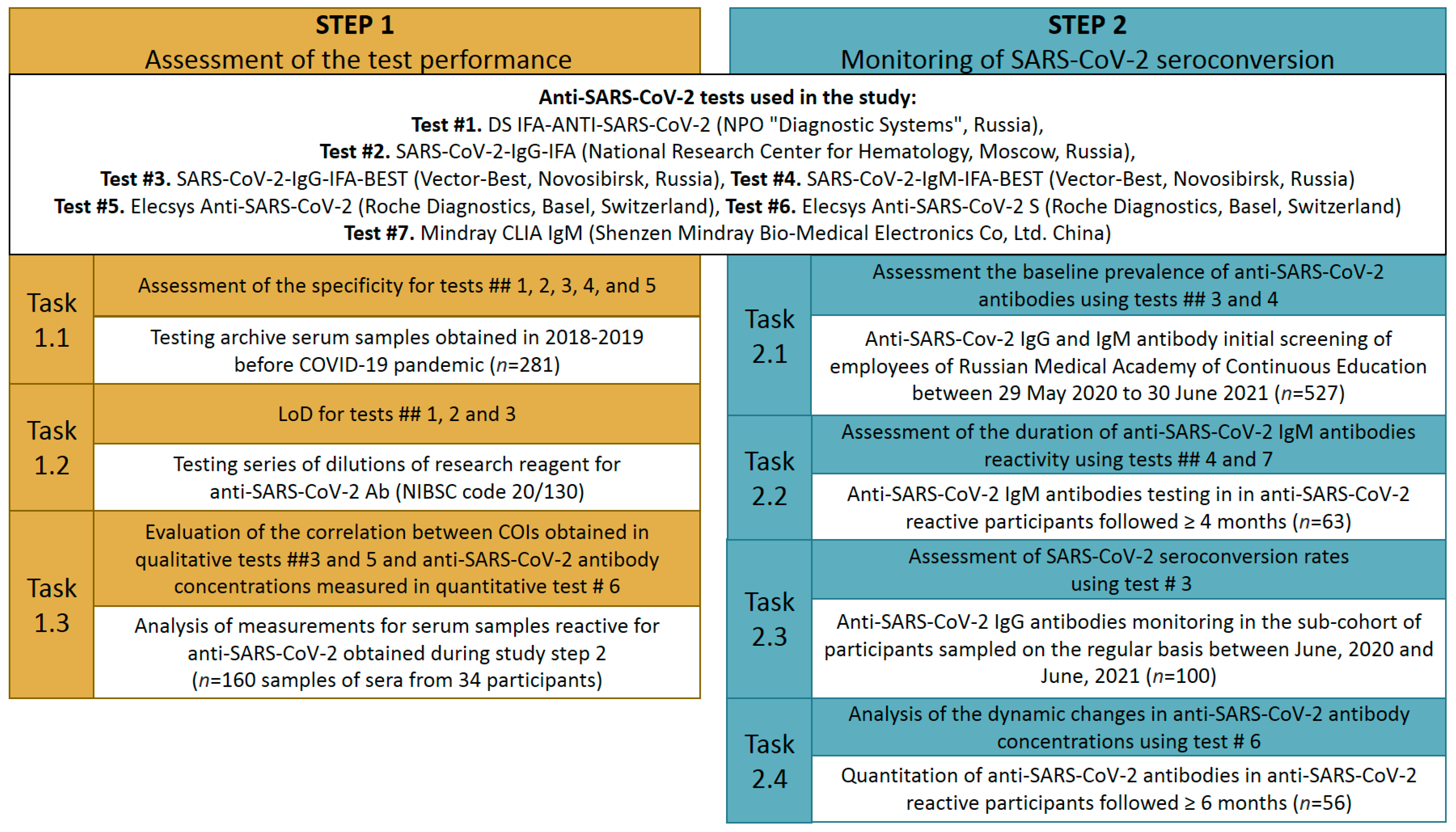
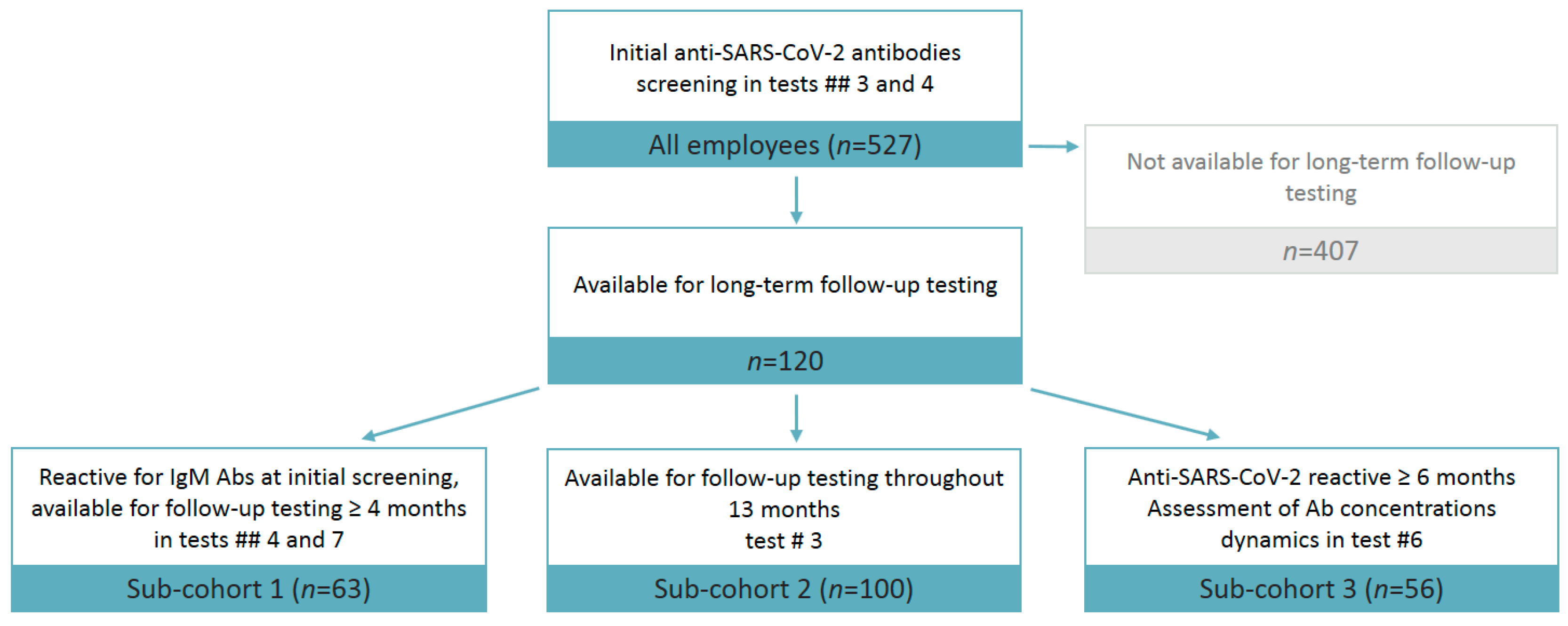

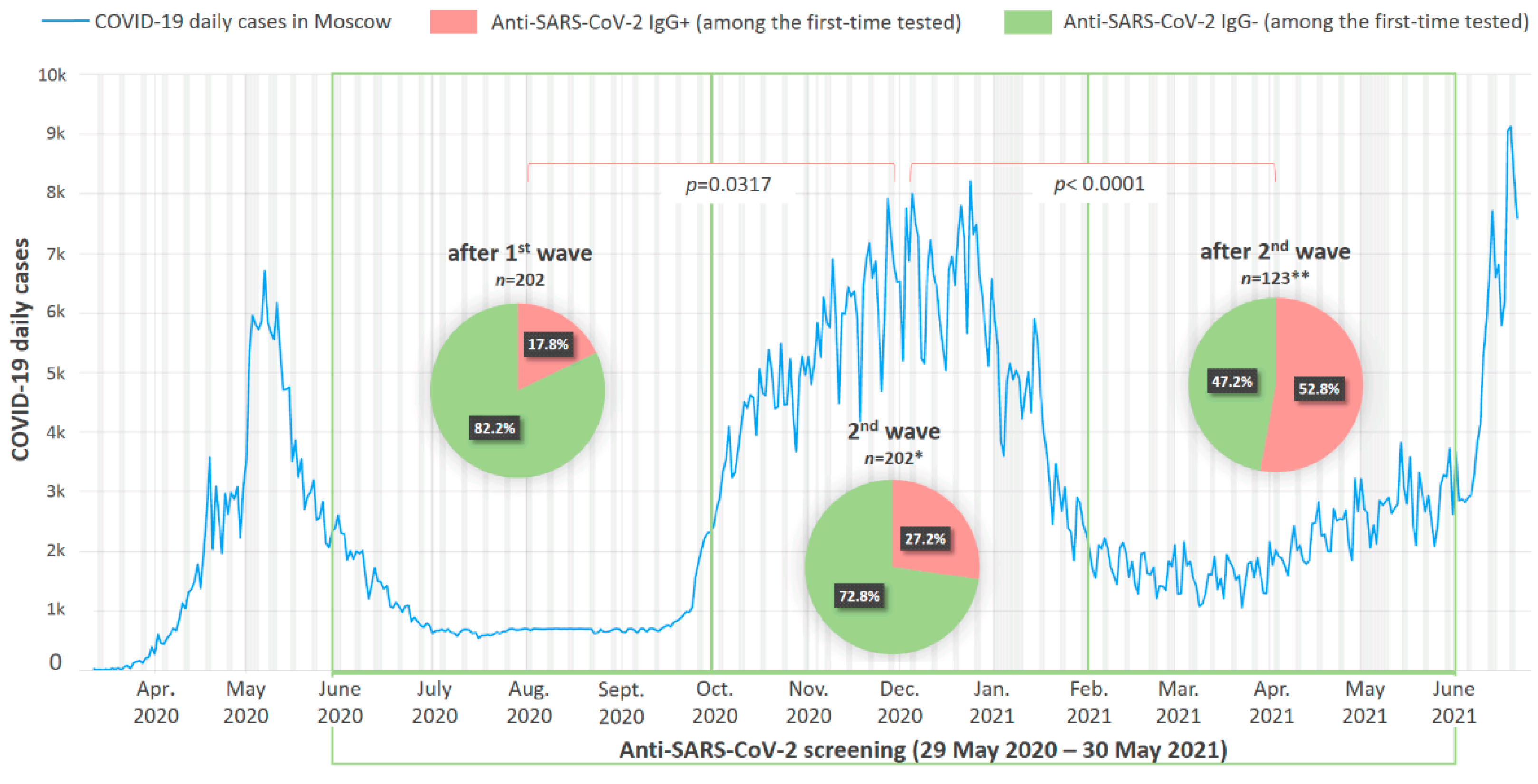

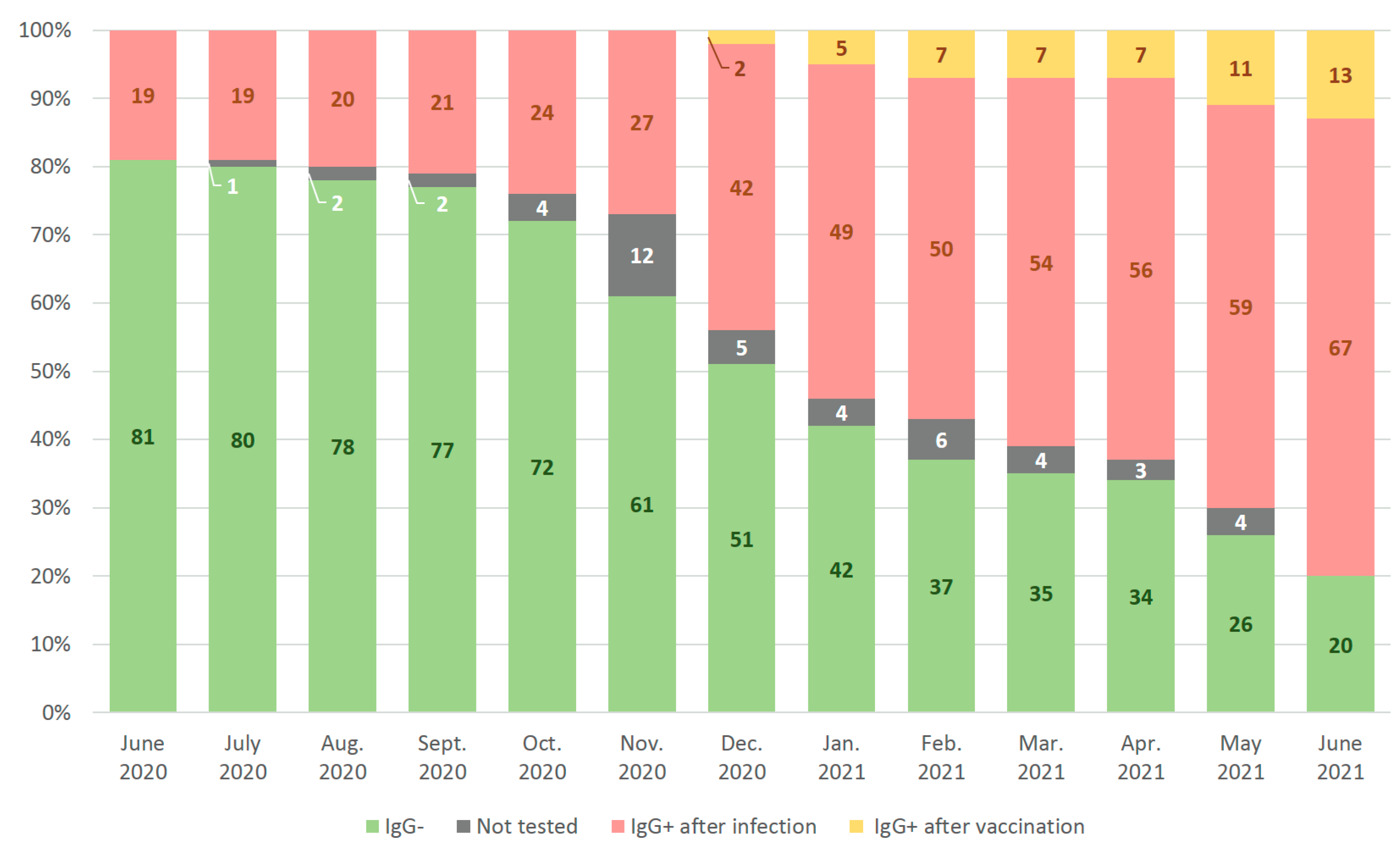
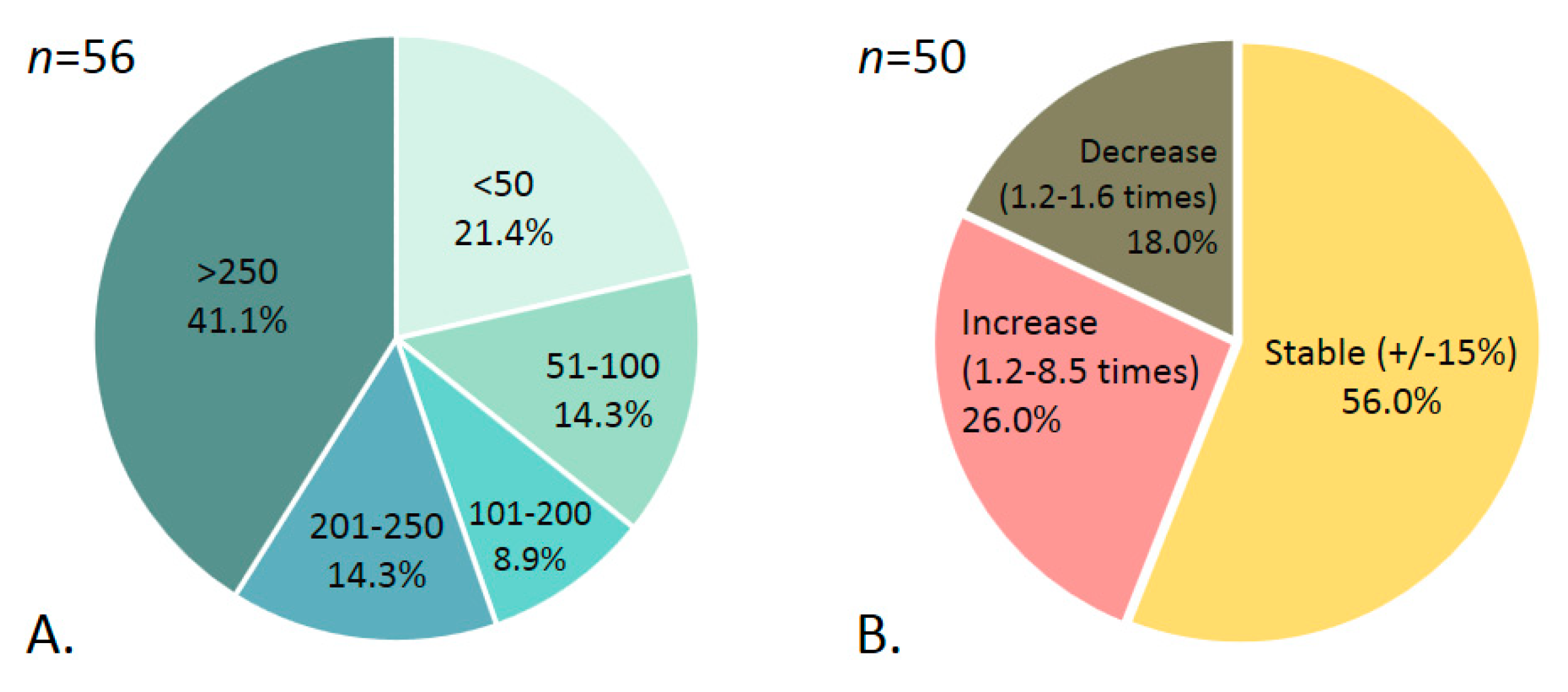
| Test No. | Test System (Manufacturer) | Type of Test | Antibody Isotype | Target Protein | Positive Result | Grey Zone |
|---|---|---|---|---|---|---|
| 1 * | DS IFA-ANTI-SARS-CoV-2 (NPO “Diagnostic Systems”, Russia) | Qualitative, ELISA | IgG + IgM | N and S | COI > Cut-off +20% | Yes (COI between Cut-off −20% to Cut-off +20%) |
| 2 | SARS-CoV-2-IgG-IFA (National Research Center for Hematology, Moscow, Russia) | Qualitative, ELISA | IgG | S-RBD | COI ≥ 1.1 | Yes (COI from 0.9 to 1.1) |
| 3 | SARS-CoV-2-IgG-IFA-BEST (Vector-Best, Novosibirsk, Russia) | Qualitative, ELISA | IgG | S | COI ≥ 1.1 | Yes (COI from 0.8 to 1.1) |
| 4 | SARS-CoV-2-IgM-IFA-BEST (Vector-Best, Novosibirsk, Russia) | Qualitative, ELISA | IgM | N and S-RBD | COI ≥ 1.1 | Yes (COI from 0.8 to 1.1) |
| 5 | Elecsys Anti-SARS-CoV-2 (Roche Diagnostics, Basel, Switzerland) | Qualitative, CLIA | Total Abs | N | COI ≥ 1.0 | No |
| 6 | Elecsys Anti-SARS-CoV-2 S (Roche Diagnostics, Basel, Switzerland) | Quantitative, CLIA | Total Abs | S-RBD | U/mL > 0.8 | No |
| 7 | Mindray CLIA IgM (Shenzen Mindray Bio-Medical Electronics Co, Ltd. China) | Qualitative, CLIA | IgM | N and S | COI ≥ 1 | No |
| Test No. | Test System (Manufacturer) | N Reactive Samples/ N Tested | Specificity of Test | Mean COI in Reactive Samples | N Samples in Grey Zone/ N Total | LoD, BAU/mL | |
|---|---|---|---|---|---|---|---|
| 1 | DS IFA-ANTI-SARS-CoV-2 (NPO “Diagnostic Systems”, Russia) | version 1 | 6/194 | 96.9% (93.3–98.7%) | 1.73 | 5/194 | n.d.* |
| version 2 | 7/194 | 96.4% (92.6–98.4%) | 1.66 | 3/194 | n.d. | ||
| version 4/5 | 2/281 | 99.3% (97.3–99.9%) | 2.79 | 3/281 | 0.1 | ||
| 2 | SARS-CoV-2-IgG-IFA (National Research Center for Hematology, Moscow, Russia) | 3/281 | 98.9% (96.8–99.8%) | 2.61 | 3/281 | 0.4 | |
| 3 | SARS-CoV-2-IgG-IFA-BEST (Vector-Best, Novosibirsk, Russia) | 4/281 | 98.5% (96.3–99.6%) | 1.80 | 2/281 | 0.5 | |
| 4 | SARS-CoV-2-IgM-IFA-BEST (Vector-Best, Novosibirsk, Russia) | 3/279 | 98,9% (97.3–99.9) | 2.11 | 1/279 | n.d. | |
| 5 | Elecsys Anti-SARS-CoV-2 (Roche Diagnostics, Basal, Switzerland) | 0/281 | 100% (98.4–100%) | - | 0/281 | n.d. | |
Publisher’s Note: MDPI stays neutral with regard to jurisdictional claims in published maps and institutional affiliations. |
© 2022 by the authors. Licensee MDPI, Basel, Switzerland. This article is an open access article distributed under the terms and conditions of the Creative Commons Attribution (CC BY) license (https://creativecommons.org/licenses/by/4.0/).
Share and Cite
Kichatova, V.S.; Asadi Mobarkhan, F.A.; Potemkin, I.A.; Zlobin, S.P.; Perfilieva, O.M.; Valuev-Elliston, V.T.; Ivanov, A.V.; Solonin, S.A.; Godkov, M.A.; Belikova, M.G.; et al. Assessment of Diagnostic Specificity of Anti-SARS-CoV-2 Antibody Tests and Their Application for Monitoring of Seroconversion and Stability of Antiviral Antibody Response in Healthcare Workers in Moscow. Microorganisms 2022, 10, 429. https://doi.org/10.3390/microorganisms10020429
Kichatova VS, Asadi Mobarkhan FA, Potemkin IA, Zlobin SP, Perfilieva OM, Valuev-Elliston VT, Ivanov AV, Solonin SA, Godkov MA, Belikova MG, et al. Assessment of Diagnostic Specificity of Anti-SARS-CoV-2 Antibody Tests and Their Application for Monitoring of Seroconversion and Stability of Antiviral Antibody Response in Healthcare Workers in Moscow. Microorganisms. 2022; 10(2):429. https://doi.org/10.3390/microorganisms10020429
Chicago/Turabian StyleKichatova, Vera S., Fedor A. Asadi Mobarkhan, Ilya A. Potemkin, Sergey P. Zlobin, Oksana M. Perfilieva, Vladimir T. Valuev-Elliston, Alexander V. Ivanov, Sergey A. Solonin, Mikhail A. Godkov, Maria G. Belikova, and et al. 2022. "Assessment of Diagnostic Specificity of Anti-SARS-CoV-2 Antibody Tests and Their Application for Monitoring of Seroconversion and Stability of Antiviral Antibody Response in Healthcare Workers in Moscow" Microorganisms 10, no. 2: 429. https://doi.org/10.3390/microorganisms10020429
APA StyleKichatova, V. S., Asadi Mobarkhan, F. A., Potemkin, I. A., Zlobin, S. P., Perfilieva, O. M., Valuev-Elliston, V. T., Ivanov, A. V., Solonin, S. A., Godkov, M. A., Belikova, M. G., Mikhailov, M. I., & Kyuregyan, K. K. (2022). Assessment of Diagnostic Specificity of Anti-SARS-CoV-2 Antibody Tests and Their Application for Monitoring of Seroconversion and Stability of Antiviral Antibody Response in Healthcare Workers in Moscow. Microorganisms, 10(2), 429. https://doi.org/10.3390/microorganisms10020429








